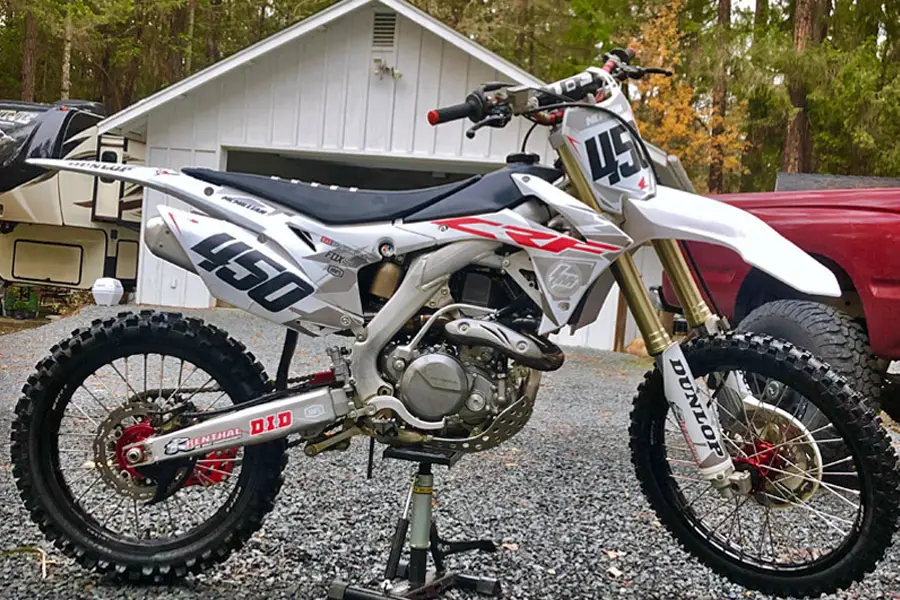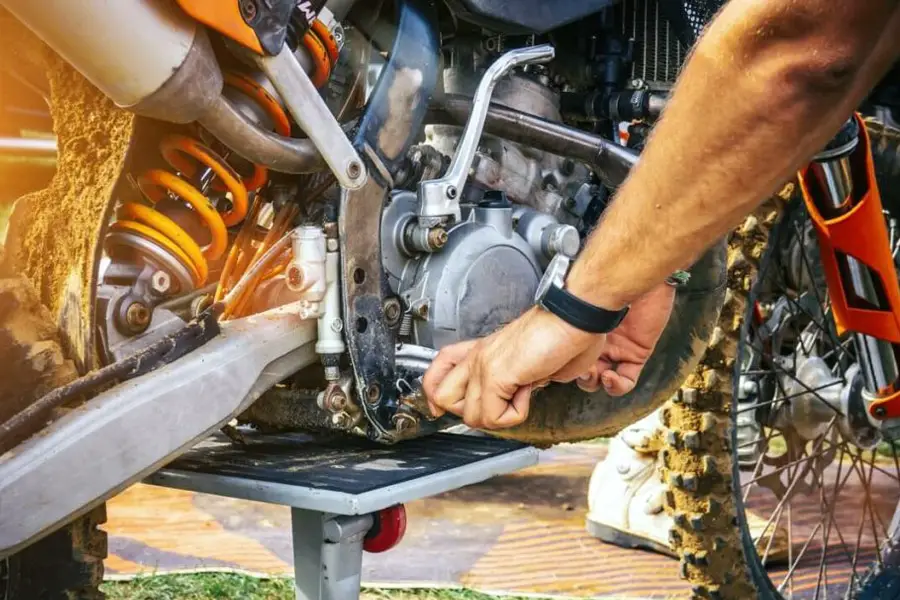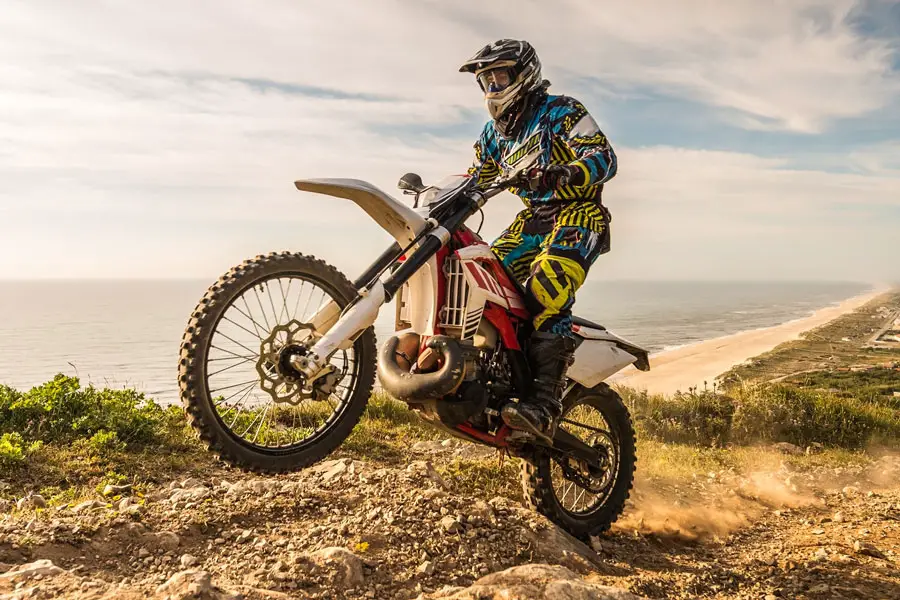Kawasaki KLX 140 Review (Top Speed, Height, Price, etc.) – Worth Buying?
BraapAcademy.com earns a small commission from qualifying purchases.
This does NOT cost you extra.
Contents
Are you considering a Kawasaki KLX140 or do you have one and you’re looking for specific specs or details on it? Either way, here’s a full Kawasaki KLX 140 review that will cover all of the need-to-knows like the top speed, weight limit, and more.
We’ll not only look at all of the dirt bike specs, we’ll also go over the maintenance requirements and other positives and negatives that come along with owning and riding one of these.
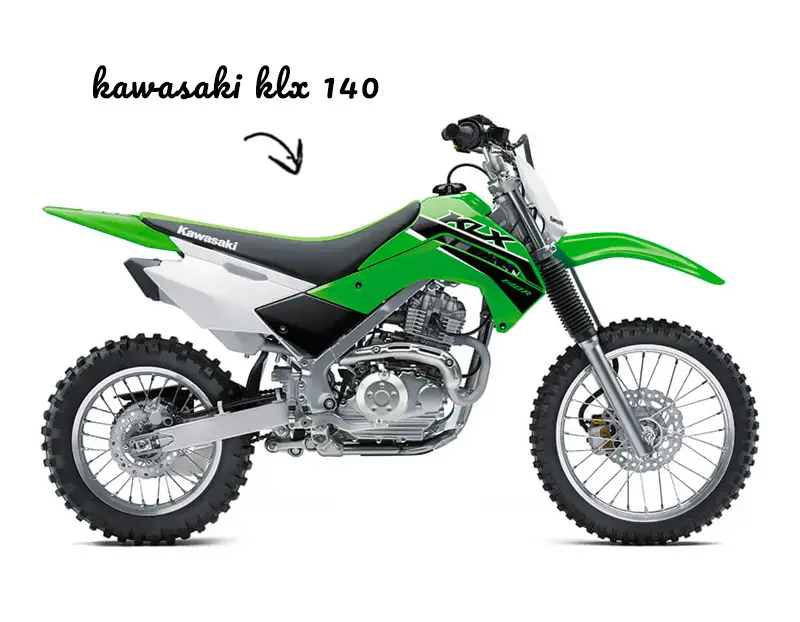
The Kawasaki 140 KLX really is a great all-around dirt bike, but that doesn’t mean it’s the right one for everyone. With that in mind, we’ll look at all of the characteristics of this beginner-friendly dirt bike and why it may (or may not) be a good fit for you.
What is a Kawasaki KLX 140?
The KLX 140 is one of Kawasaki’s best beginner dirt bikes. It is a low-budget trail bike best suited for casual riding and beginners.
There are three different KLX 140 models to choose from:
- KLX 140R
- KLX 140L
- KLX 140F
The three different motorcycles are all virtually the same bike, but with different sized wheels and tires. Yes, there are a few other details that make them different, but other than the adjustable suspension (on the “F” model) and the different seat heights of the dirt bikes, there really isn’t much of a difference.
KLX 140R, 140L, 140F Differences
Again, there are three different Kawasaki KLX 140 dirt bikes:
- KLX 140R
- KLX 140L
- KLX 140F
When compared, the significant differences are seat height, overall dirt bike height, weight, and wheel size. Yes, there are other slight differences, but at the end of the day, they’re all basically the same dirt bike.
Here are the differences between the three:
| KLX 140R | KLX 140L | KLX 140F | |
|---|---|---|---|
| Overall Height | 41.3″ | 42.3″ | 44.7″ |
| Seat Height | 30.7″ | 31.5″ | 33.9″ |
| Weight | 205 lbs | 209.4 lbs | 218.2 lbs |
| Front Suspension | 7.1″ travel | 7.1″ travel | 7.5″ travel |
| Rear Suspension | 5-way preload adjustability (7.1″ travel) | 22-way rebound damping (7.1″ travel) | 20-way rebound damping and threaded preload adjustability (7.9″ travel) |
| Front Tire | 70/100-17 | 70/100-19 | 2.75×21 |
| Rear Tire | 90/100-14 | 90/100-16 | 4.10×18 |
| Rake/Trail | 27°/3.3″ | 27°/3.8″ | 27°/4.6″ |
| Overall Length | 71.7″ | 74.6″ | 78.9″ |
| Ground Clearance | 9.3″ | 10.0″ | 12.4″ |
| Wheelbase | 49.6″ | 50.6 | 52.4″ |
Who Should Buy?
Overall, a Kawasaki KLX 140 is a good dirt bike for fun, casual riding, and it is one of the best beginner dirt bikes on the market.
Depending on your personality and age (or your child’s) this could be a great dirt bike to learn on. The size, gearing, and power of these KLX 140 dirt bikes are perfect for learning.
It’s a great choice for young riders and a good alternative to a Honda CRF 150 dirt bike or the next logical step up from it’s little brother, the Kawasaki KLX 110 dirt bike.
History
As mentioned, the Kawasaki KLX 140 history dates back to 2008. Since then, the different KLX 140 models haven’t changed much throughout the years.
In 2010 Kawasaki released a completely redesigned KLX 110, however the 140cc dirt bike didn’t get a complete overhaul like it’s little brother. What it did get, however, was the addition of a taller, “L” option.
The Kawasaki KLX 140L was first released in 2010, and has been a successful seller ever since.
In addition, Kawasaki also offers the KLX 140F, which is even slightly taller than the “L” model.
Kawasaki KLX 140 Specs
Here are the Kawasaki KLX 140R, 140L, and 140F specifications that I grabbed from the Kawasaki website:
| Model | KLX140R KLX140R L KLX140R F |
| Engine Type | 4-stroke single, SOHC, air-cooled |
| Bore and Stroke | 58.0 x 54.4mm |
| Compression Ratio | 9.5:1 |
| Fuel System | 20mm Keihin carburetor |
| Ignition | Digital DC-CDI |
| Transmission | 5-speed, return shift, with wet multi-disc manual clutch |
| Final Drive | Chain |
| Suspension | Front: 33mm telescopic fork (7.1 inches of travel) Rear: Uni-Trak® linkage system and single shock with 5-way preload adjustability (7.1 inches of travel) |
| Brakes | Front: Single 220mm petal disc with a dual-piston caliper Rear: Single 186mm petal disc with single-piston caliper |
| Tires | R-Model: 70/100-17 front, 90/100-14 rear L-Model: 70/100-19 front, 90/100-16 rear F-Model: |
| Wheelbase | R-Model: 49.6 inches (1260mm) L-Model: 50.6 inches (1285mm) F-Model: 52.4 inches (1330mm) |
| Rake (Caster Angle) | 27° |
| Trail | R-Model: 3.3 inches (84mm) L-Model: 3.8 inches (96mm) F-Model: 4.6 inches (117mm) |
| Seat Height | R-Model: 30.7 inches (780mm) L-Model: 31.5 inches (802mm) F-Model: 33.9 inches (861mm) |
| Ground Clearance | R-Model: 9.3 inches (236mm) L-Model: 10 inches (254mm) F-Model: 12.4 inches (315mm) |
| Curb Weight | R-Model: 205 pounds (73kg) L-Model: 209.4 pounds (95kg) F-Model: 218.2 pounds (99kg) |
| Fuel Capacity | 1.5 gallons |
| Color | Lime Green |
I’ve picked out the important KLX 140 specs that most of us are looking for, and added a few of the missing ones here:
Manufacturer: Kawasaki
Common Name: Kawasaki KLX 140
R-Model: KLX140R, KLX 140 R, KLX 140R
L-Model: KLX140L, KLX 140 L, KLX 140L, KLX140RL, KLX 140 RL, KLX 140RL
F-Model: KLX140F, KLX 140 F, KLX 140F, KLX140R-F, KLX 140 RF, KLX 140RF
Dirt Bike Type: Offroad, Trail dirt bike
Years Made: 2008-2023 (present)
R-Model, Seat Height: 30.7″
L-Model, Seat Height: 31.5″
F-Model, Seat Height: 33.9″
R-Model, Curb Weight: 205 lbs.
L-Model, Curb Weight: 209.4 lbs.
F-Model, Curb Weight: 218.2 lbs.
Top Speed: 50-55 mph
Horsepower: 9 hp (from factory)
KLX 140cc Engine & Transmission
These Kawasaki 140 dirt bikes are well-known for being durable, dependable, and easy to maintain.
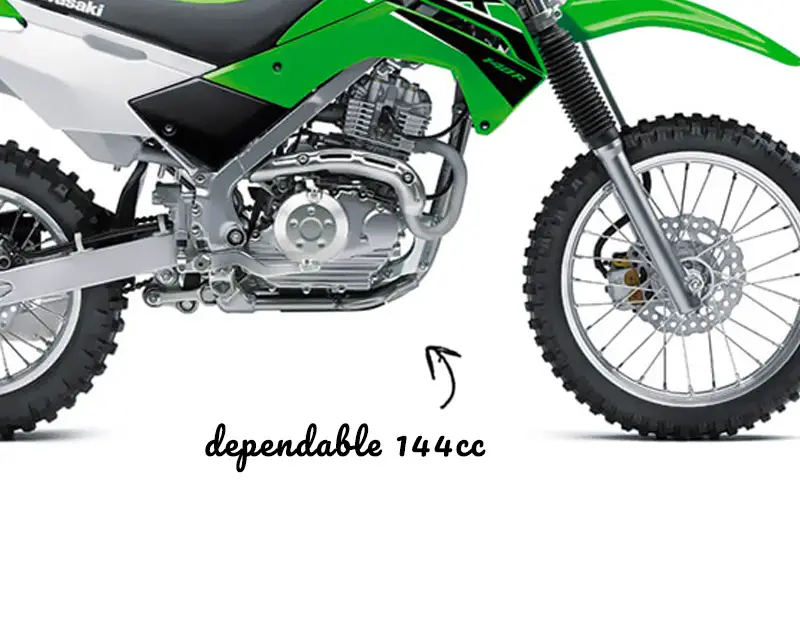
Even though the KLX dirt bikes aren’t the fastest or best jumping Kawasaki dirt bikes on the market, they are great for what they were designed to do.
The 144cc engine is a high-revving and delivers a smooth, controllable power, making it one of the best dirt bikes for pre-teens, teens, and small adults.
Horsepower
A stock Kawasaki KLX 140 has 9 horsepower from the factory.
While only 9 hp may seem a bit low, it’s actually a decent amount for this type of dirt bike. Remember, these dirt bikes are designed for easy, slow to mid-speed rides. These engines are made to deliver good low-mid range power.
So, while you’re out cruising around on trails, you’ll have plenty of power.
These small dirt bikes are not designed to produce impressive horsepower numbers. Instead, they’re designed to produce useable horsepower that is easy to roll-on and control.
The 140 KLX isn’t going to shoot a killer roost like some of these other motocross dirt bikes out there, but their roll-on the power and control make for an enjoyable ride.
Top Speed
How fast does a KLX 140 go? Good question.
A stock Kawasaki KLX 140 top speed ranges around 50-55 MPH, give or take a few. Is 55 mph the maximum speed a KLX 140 can go? Not necessarily. There are some mods that will make the bike faster.

There are a handful of different methods to make KLX 140 go faster. One of the easiest is ways is by changing out the stock gearing for taller gearing. This can be as easy as replacing the rear sprocket, front sprocket, or both sprockets.
Unfortunately, you probably won’t want to make the gears any taller. Whenever you increase a dirt bike’s top speed by changing the gear ration to be taller, you lose low-end and mid-range power. Usually, that’s NOT worth the sacrifice on a trail bike that you really don’t need to go much faster on.
Overall, a stock Kawasaki KLX 140 dirt bike with no mods done to it, it should go about 55 MPH. That’s plenty fast for a small trail bike.
Engine Specs
Engine Size: 144cc (considered a 140cc)
Horsepower: 9 HP
Engine Type: 4-stroke single, SOHC, air-cooled
Transmission: 5-speed, return shift, with wet multi-disc manual clutch
Starting: Electric start and Kick start
Cooling System: Air-cooled
Fuel Capacity: 1.5 gallons
Fuel Type: Petrol / Gasoline
Supply: Carburetor (the KLX 140 is not fuel injected)
Maintenance
The minimal Kawasaki KLX140R dirt bike maintenance schedule is one of the bike’s better selling points. These 140cc trail bikes don’t need anywhere near as much maintenance as the other motocross-style dirt bikes.
In fact, as long as you’ve got a few of the necessary tools in your Kawasaki tool kit, and you’ve kept up on the maintenance, you shouldn’t experience many issues with these bikes.
Also, the main type of maintenance that these bikes need is fairly straightforward. For example, you’ll want to make sure to check and change the oil, keep your dirt bike chain adjusted and put the correct chain lube on, and keep your dirt bike air filter clean. If you keep up on these types of to-dos, the dirt bike will last many years.
What motor oil does a Kawasaki KLX 140 use? Kawasaki Performance 4-Stroke Oil – SAE 10W-40
Oil Capacity:
1.13 L (1.19 US qt) (When filter is not removed)
1.15 L (1.22 US qt) (When filter is removed)
1.30 L (1.37 US qt) (When engine is completely dry)
How much maintenance does a KLX 140 need?
Here is the maintenance list that I took from the owner’s manual. This will at least give us a clear view of what the maintenance requirements for this dirt bike are.
Spark plug – clean and inspect
Clutch plates – inspect
Clutch – inspect
Valve clearance – inspect
Air cleaner element – clean
Idle speed – inspect
Throttle cable – inspect and adjust
Fuel tap – clean
Spark arrester – clean
Engine sprocket – inspect
Fuel hose, connections – inspect
Brake – adjust
Brake lining wear – inspect
Brake camshaft – lubricate
Spoke tightness and rim runout – inspect
Drive chain – inspect and adjust
Drive chain – lubricate
Drive chain wear – inspect
Drive chain guide and slipper – inspect
Front fork – clean and inspect
Front fork oil – inspect
Nuts, bolts, fasteners – inspect
Steering play – inspect
Steering stem bearing – lubricate
Rear sprocket – inspect
Battery – inspect
Battery terminal – inspect
General lubrication – perform
Side stand – inspect
Wheel bearing – inspect
Swingarm pivots – inspect
Rear shock absorber – inspect
Frame – inspect
Wheels/tires – inspect
Cable – inspect
Yes, that is a long list, however, It’s actually a lot less than it seems like.
Basically, any dirt bike you get will come with an owner’s manual that will give you ALL of the maintenance that you should do. That’s wha the list above is.
What isn’t shown in the KLX 140 maintenance schedule above is the frequency in which you’re required to perform these inspections and adjustments.
Most of the items listed above are required after the initial (first) 5 hours of riding. After that, the schedule calls for most of the items to be inspected and/or adjusted after every 50 hours of riding.
By contrast, a Honda CRF450RX requires most of these items to be inspected and/or adjusted after every 2.5 hours of riding. That makes a difference!
Kawasaki KLX 140 Handling
The KLX140R is good, but not the absolute “best” handling dirt bike. It’s suspension and handling is somewhere in the middle, but that actually translates into a fairly easy ride.
Much like it’s 110cc little brother, the low center of gravity and low seat height are great for beginner riders. Because of this, the KLX 140 is very easy to control and ride.
In most cases, kids will learn to ride a smaller bike and then bump up to a mid-sized dirt bike like this. Either way, once a child graduates from a 100cc (or 110cc, or similar), this 140cc is a great next step.
Weight
The curb weight of the Kawasaki KLX 140 is between 205 – 218 pounds, depending on which model you choose.
Here are the three different weights for each KLX model:
- KLX 140R weighs 205 pounds (73kg)
- KLX 140L weighs 209.4 pounds (95kg)
- KLX 140F weighs 218.2 pounds (99kg)
What is curb weight on a dirt bike?
The difference between “curb weight” and “dry weight” is all in the “fluids” that a dirt bike requires… mostly the fuel.
Therefore, the “dry weight” on a dirt bike will not included the the extra weight of a full tank of fuel. On the other hand, the “curb weight” on a dirt bike does will include the fuel and oils.
Really, it doesn’t actually make a difference which weight you’re using to compare dirt bikes as long as you compare dry-to-dry, or wet-to-wet.
What’s the KLX 140 weight limit?
Does the Kawasaki KLX 140 have a weight limit? Yes, the owner’s manual states the following:
“KLX140A is designed for a rider weighing less than 70 kg (154 pounds). Exceeding this limit could damage the motorcycle.“
If you weigh more than 154 pounds you can still ride the bike, however it will not perform as well.
Most noticeably, you’ll find the suspension a bit soft. If this is the case, you’ll want to upgrade the suspension. A heavier rider will find the suspension too soft and it will bottom out often.
Seat Height
The Kawasaki KLX 140 seat height measures between 30.7-33.9 inches off of the ground, depending on which model you choose. The standard, 140R model is the shortest, the “L” model is about 1.25 inches taller, and the “F” model is about 2.5 inches taller than the “L” model.
- KLX 140R seat height: 30.7 inches
- KLX 140L seat height: 31.5 inches
- KLX 140F seat height: 33.9 inches
With a fairly low seat height of just under 31 inches, the 140R is a good dirt bike for tall 12 year olds, teens, or anyone else who’s around 4’10” – 5′ tall.
If you’re taller, the KLX 140R-L is the next size up, with a seat height of 31.5 inches off of the ground, while the KLX 140R-F is the tallest 140cc of the bunch at 33.9 inches.
As long as you’re buying a new KLX140, or the previous owner(s) didn’t make and adjustments to a used one, this gives you an idea on what size rider is best suited for these dirt bikes.
Suspension
Depending on the weight of the rider and the type of riding, the KLX 140 suspension is good for what it is designed to do.
Because this is more of an entry-level dirt bike, and it’s certainly not MX race bike, the suspension isn’t designed for high performance or extreme riding.
Overall, the suspension is a little soft for advanced riders, but it works great and is forgiving for slow speed, non-aggressive riding.
Just remember… these softer, trail-riding setups are not effective for motocross or supercross tracks where you’ll be hitting whoops, doubles, tabletops, and hair-pin turns.
KLX 140R Model:
Front suspension: 33mm telescopic fork (7.1 inches of travel)
Rear suspension: Uni-Trak® linkage system and single shock with 5-way preload adjustability (7.1 inches of travel)
KLX 140R L Model:
Front suspension: 33mm telescopic fork (7.1 inches of travel)
Rear suspension: Uni-Trak® linkage system and single shock with piggyback reservoir, fully adjustable preload and 22-way rebound damping (7.1 inches of travel)
KLX 140R F Model:
Front suspension: 33mm telescopic fork (7.5 inches of travel)
Rear suspension: Uni-Trak® linkage system and single shock with piggyback reservoir, 20-way rebound damping and threaded preload adjustability (7.9 inches of travel)
If you’re looking for a small dirt bike that you can also jump and rip around on the track, this will work, but it will take a few mods. Of course, it’ll take a few more expensive mods to make this an adult-ready, mini-moto track bike than it will to make race-ready for a child. But either way, it can be done.
Handling Specs
Chasis
Frame Type: High-tensile steel, box-section perimeter
Brakes
Front Brake: Single 220mm petal disc with a dual-piston caliper
Rear Brake: Single 186mm petal disc with single-piston caliper
KLX 140R Wheels and Tires Size:
Front Tire Size: 70/100-17
Rear Tire Size: 90/100-14
KLX 140L Wheels and Tires:
Front Tire Size: 70/100-19
Rear Tire Size: 90/100-16
KLX 140F Wheels and Tires Size:
Front Tire Size: 2.75×21
Rear Tire Size: 4.10×18
Is the Kawasaki 140 a Good Dirt Bike?
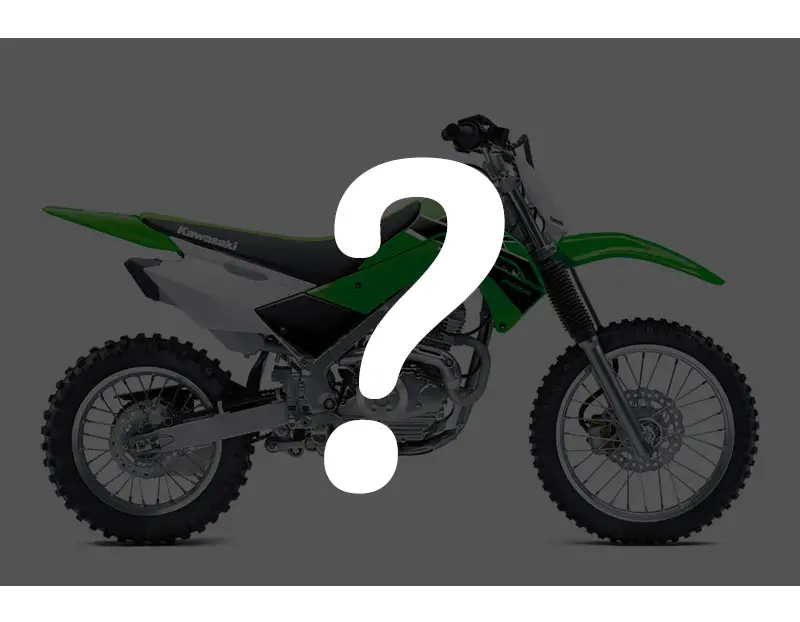
Yes, the Kawasaki 140 is a good dirt bike to buy, own, and ride. However, it isn’t the best choice for everyone, so here is a quick overview of reasons one should, or should not, consider getting one.
Reasons to buy:
- You want a good dirt bike to learn on and take trail dirt riding
- It’s a good dirt bike for kids 4’10 or taller
- If you’re looking for a small to midsize dirt bike
- You’re not looking for a motocross bike
- A buddy of yours is selling you one and… why not!?
Reasons not to buy:
- You need a motocross, track-ready dirt bike
- Finding one in good condition can be tough… hold out for a nice one
- If you’re a 180 pounder, you’ll need to do some suspension mods for it to perform as intended
Positive Reviews
Okay, overall the Kawasaki 140 KLX is a great dirt bike that suits a variety of riders. Here are a few of the positives this bike is known for:
- Proven reliability
- Beginner-friendly power and handling
- Good power and torque for beginner riders
- Simple to work on and maintain
- Smooth, controllable power from the Kawasaki 140cc
- Electric start
Negative Reviews
Again, there’s not one dirt bike that can be good at everything. Here are a few of the negatives this dirt bike is known for:
- Suspension isn’t good for big or aggressive riders
- Many KLX 140 dirt bikes have been neglected (because they need minimal maintenance)
- Hard to find newer models for sale
- Not an aggressive, high-performance machine
Buyers Guide (Best Year, Pricing, etc.)
So… Now that you’ve done your research, where do you find one for sale?
You can purchase a brand new model from your local dealer, or you could search the internet or local papers (do they still print those?). Whenever looking to buy used dirt bike, I basically always resort to these three options:
- Kawasaki Dealer (new)
- Craigslist
- Facebook Marketplace
- Friend-of-a-Friend
Of course, there are several more places to find a used 140 Kawasaki KLX for sale, but I like checking CL and FB first. You really should see a dirt bike in person, start it up, ride it, and inspect it before buying it, and this provides us with that option.
What is the best year for a Kawasaki KLX 140 dirt bike?
The good news: any year is a good year.
Kawasaki hasn’t needed to make many changes to these bikes throughout the years. After all, why “fix” something if it isn’t broken. These are popular, affordable, and fun to ride.
NOTE: Kawasaki did find something to fix. In 2021 they streamlined the various names of these bikes. Now, they’ve got a more traditional standard: the KLX 140R, KLX 140R L, KLX 140R F.
How much does a new Kawasaki KLX 140 cost?
A brand new 2023 Kawasaki KLX 140R costs $3,449, the KLX 140R L costs $3,749, and the KLX 140R F costs $4,049. Here’s the pricing snippet for the “R” that I grabbed straight from the Kawasaki website:
MSRP: $3,449
Destination Charge: $245
Freight and Materials Surcharge: $200
Dealer sets the actual destination charge, your price may vary.
Specifications and pricing are subject to change.
How much is a used Kawasaki KLX 140 worth?
In order to get an accurate value for a used 140 Kawasaki KLX, all we have to do is a little research.
First, we can check Kelley Blue Book and see that it lists a 2019 Kawasaki KLX 140 is worth somewhere around $2,900.
Technically, the KBB value is $1,955 for the “Trade-In Value” and $2,885 for the “Typical Listing Price” value.
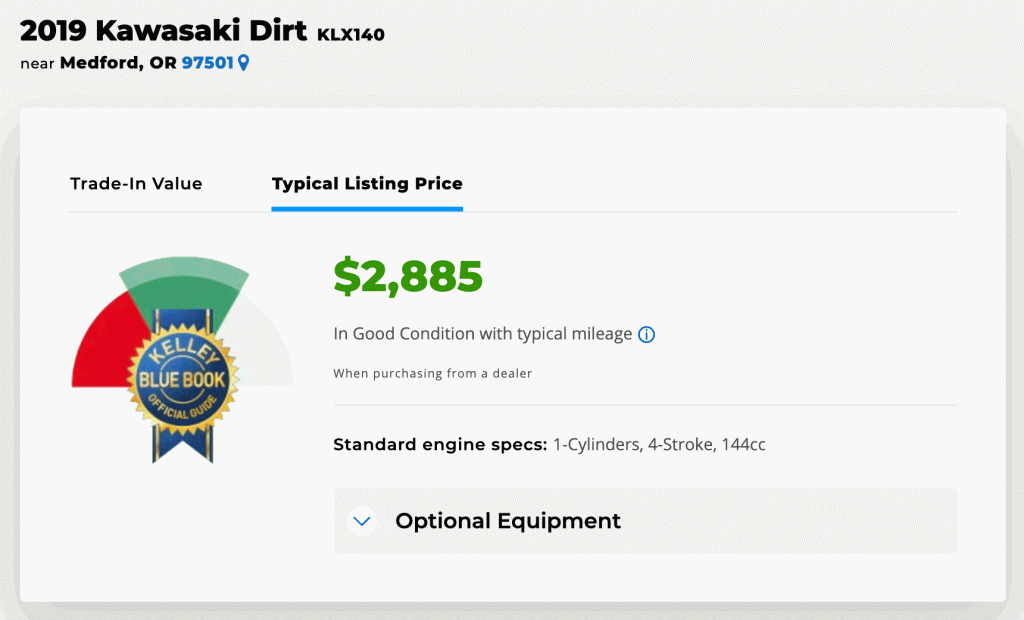
Now that we have that price range, we can do a quick search on Facebook Marketplace to compare.
With that, I was able to find a handful of used KLX 140 dirt bikes for sale… five, to be exact.
Here are the Kawasaki KLX 140 years that I was able to find for sale on FB Marketplace:
- 2008 – $2,200 (decent shape, new rear tire)
- 2020 – $3,200 (seems like new)
- 2021 – $3,500 (looks and sounds like it was well maintained)
- 2021 – $3,500 (lots of extras)
- 2022 – $3,000 (only 20 hrs on bike)
Of those, I’d check out the 2020 for $3,200. It looked and sounded new. Here’s the ad from Facebook:
Basically brand new 2021 Kawasaki KLX 140. Bought it for the wife she rode it one time for less than an hour. Great little bike bought it from Kawasaki Dealership. $3,200 obo
I also decided to look on Craigslist to see how how many I could find, and for how much.
I was only able to find one, and it wasn’t even within 100 miles of me. It was another ’21 Kawasaki 140R that was listed for $3,400. Here’s the ad:
2021 KLX 140 – $3,400
Like new, maybe 2-3 hours.
14″ rear tire
17″ front tireUpgraded handlebars, grip and levers.
New bike will cost you $4,500?
$3,749 MSRP
+ $245 Destination Charge
+ $200 Freight and Materials Surcharge
+ $200 Set up fee
+ $375 Approx tax
Is the Kelley Blue Book dirt bike pricing accurate?
The KBB prices are usually on the low end, and that seems to be the case here. The price ranges that these bikes are listed between range from about $1,900-$2,900.
Overall, I’d say a real-world value falls between $2,000-$3,500 for one of these. I’d be looking to spend high $2,000’s for a really nice one.

